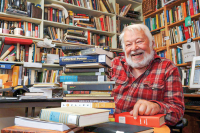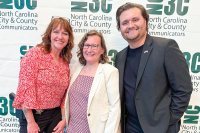Parrying continues over Cowee School
 Now that the children are gone, and art projects sit abandoned next to overturned desks and emptied cupboards, community members have a vision to bring life back into the old Cowee school outside of Franklin. But the community’s path to reclaiming the schoolhouse is facing growing opposition in the Macon County government as to how the initiative should be funded.
Now that the children are gone, and art projects sit abandoned next to overturned desks and emptied cupboards, community members have a vision to bring life back into the old Cowee school outside of Franklin. But the community’s path to reclaiming the schoolhouse is facing growing opposition in the Macon County government as to how the initiative should be funded.
This year marks the first school session in which the students have been bused to a newly built school nearby, leaving the stone schoolhouse, once the site of a bustling Civilian Conservation Corps camp, deserted.
The school has amenities that could serve varied purposes. It contains a gymnasium that can seat about 250 people, rows of former classrooms equipped with storage cabinets and hardwood floors, as well as a commercial kitchen and cafeteria. Outside are baseball diamonds and a playground.
If all goes as planned, soon the building will be filled again with people shuffling in and out to attend quilting classes, see a Cherokee historical exhibit or enjoy a musical performance in the gymnasium. There are also talks of a local farmer’s market and community garden on the grounds.
It’s location, only a 10-minute drive from Franklin, offers the potential to attract people from the population center to the small historic district off the beaten path.
“Publicly, the idea has been very popular,” said Stacey Guffey, a consultant working with Macon County revitalize the school. “Although the community in Cowee got the ball rolling, the idea is for it to serve the entire county.”
Related Items
Yet, the future of the project is uncertain.
On Tuesday, Macon County Commissioners voted on whether to accept the property, for free, from the school district. Commissioners had already approved a contract with Guffey to contribute nearly $70,000 to the organization and renovation of building.
Guffey estimates the Cowee school will need about three years of financial support from the county before it can function on its own from grants, contributions and other fees it collects.
But to reach the three-year mark, Guffey will have to stand again before the county commissioners at least one more time before the contract expires in June 2013 and plead his case for more support.
Yet now his funding has one less ally on the board. Paul Higdon, a conservative who has already vocalized his distaste for using county funds in such a manner, replaced Democrat Bobby Kuppers, a proponent of the project in the Nov. 6 election.
Higdon said he does not support the county funding to turn the old Cowee school into a cultural heritage center. For Higdon, his opposition goes all the way back to the decision to close the old Cowee school in the first place.
“I thought personally saving all these community schools is better than consolidating,” Higdon said in an interview for a campaign story that ran before the election. Higdon pointed to other schools that were closed during consolidation, like Iotla school, that were not kept by the county.
“Where is it fair to destroy the community center of one community and use taxpayer dollars to fund the preservation of another school?”
Furthermore, Ron Haven, the lone commissioner to vote against the contract, vows he will oppose granting more county funds to Guffey in the future as well. Haven is uncomfortable with Guffey’s association with the conservation organization Land Trust for the Little Tennessee and doesn’t feel it’s prudent to hand over taxpayer funds to what he calls a special-interest group.
He said his philosophy applies to any special-interest group.
“I’ll do anything I can for that community,” said Haven. “But I’m responsible for making sure I get the very best out of tax dollars, and I don’t see donating money to special-interest groups as being the best way of spending of that money.”
He said he would like to see the Cowee school, and other historic ones like it, be used by the community. However, he disagrees with how the initiative is being funded.
However, according to Guffey, without public funds, the building will most likely have to be sold to a private entity. Nearby Otto school, which has a similar design as the Cowee school and was abandoned for similar reasons, was sold to a private company.
Simply maintaining public grounds and facilities has hidden costs. It’s easy, without constant upkeep, for these buildings to slip into disrepair and become a money drain.
Already there are leaks in the Cowee school that need fixing. And the price of keeping it comfortable for potential visitors is even higher. One of the largest drains is heating the facility — by means of an expensive, oil-fired steam furnace.
Guffey said he and others in the county are trying to make sure that it stays in the public realm. Residents have been meeting since 2005 — in anticipation of the day when the school would be phased out and the building abandoned — to make transition plans. A meeting in 2010 drew close to 100 people who came to discuss the future of the building.
Nonetheless, the project’s opposition doesn’t stop Guffey and those community members from dreaming big.
With the building’s close proximity to other historic landmarks — such as the Rickman General Store built in 1895, a famous 1920s African-American church and the Cowee Cherokee mound dated to 600 A.D. — many hope the 1943, art-deco school will add to the list of destinations in Cowee.
The community was once an epicenter of Cherokee and pioneer activity in the region, attracting traders and merchants from all over.
“We would like for this to be a destination for heritage and history tourism,” said Guffey. “Cowee was once famous as far away as Charleston.”
The Cowee vision
The following is an abbreviated list of the rooms in the Cowee school and some of their proposed uses in a community center setting:
• Principal’s Office — retail space and reception area
• Gymnasium and stage — performances, dances, and fitness classes
• Lounge — administration and workroom
• Library — community meeting room
• Cafeteria — shared-use kitchen, events and gatherings
• Classrooms — historical exhibits, pottery, quilting, crafts and meeting areas









